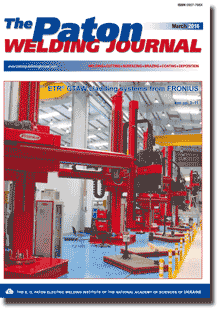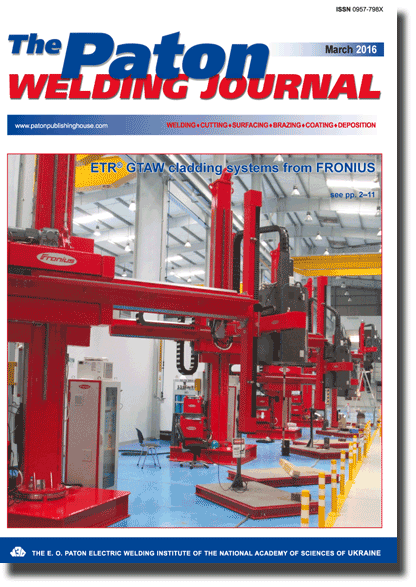Access for download PDF files for subscribers and for reviewers of scientometric bases.
Organization: Elsevier for content access(PDF files of journals released before 2024 are available for download from the website's archives))
Organization: Elsevier for content access(PDF files of journals released before 2024 are available for download from the website's archives))
| 2016 №03 (03) |
DOI of Article 10.15407/tpwj2016.03.04 |
2016 №03 (05) |

The Paton Welding Journal, 2016, #3, 24-27 pages
Calculation-experimental method for determination of spectrum components of non-stationary loading of carbon steel welded joint
A.A. Lukashevich
G.S. Pisarenko Institute for Problems of Strength, NASU. 2 Timiryazevskaya Str., 01014, Kiev, Ukraine. Е-mail: ips@iрр.kiеv.uа
Abstract
The time parameters of the spectrum components of non-stationary loading of welded joints of carbon steel were determined, having a dominant influence on the intensity of fatigue fracture of the structural elements of railway locomotives. A new method was offered for analysis of the results of strain gauge measuring of the evolution of deformation heterogeneity in the welded joint HAZ in the process of fatigue crack development. It was established that in each unit of loads at certain frequencies, the deformations exist which are dominant at fatigue fracture. 12 Ref., 5 Figures.
Keywords: non-stationary loads, fillet welded joint, carbon steel, fatigue crack growth, strain gauge null-indicator method, time-frequency analysis
Received: 20.01.16
Published: 28.04.16
References
- Harris, W.J., Zakharov, S.M., Landgren, J. et al. (2002) General conclusions of advanced experience of heavy-loaded traffic: Problems of interaction between wheel and rail. 1st Moscow: In-tekst.
- Basov, G.G., Falaleev, N.I., Yatsko, S.I. (2004) Modern methods of design of locomotive servicing parts. Transport Ukrainy, 4, 39–45.
- Makhnenko, V.I. (2006) Resource of safe operation of welded joints and units of modern structures. Kiev: Naukova Dumka.
- DSTU 2651–94: Ordinary carbon steel. Valid 01.01.96. Kyiv: Derzhstandart Ukrainy.
- GOST 25.502–79: Calculations and strength tests in machine-building. Methods of mechanical tests of metals. Methods of strength tests. Valid 01.01.81. Moscow: Standart.
- GOST 5264–80: Manual arc welding. Welded joints. Main types, structural elements and sizes. Valid 01.07.81. Moscow: Standartinform.
- Troshchenko, V.T., Tsibanev, G.V., Gryaznov, B.A. et al. (2009) Fatigue of metals. Influence of surface state and contact interaction. Vol. 2. Kiev: IPP.
- Leonets, V.A., Lukashevych, A.O., Degtyarev, V.O. et al. (2012) Assessment of the null-indicator method for the detection of fatigue cracks in structural elements. Strength of Materials, 44(3), 325–332. https://doi.org/10.1007/s11223-012-9385-2
- Tokarev, O.D., Leonets, V.A., Leonets, A.A. et al. (2002) System of dynamic-strength tests of load-carrying structures of rolling stock and track structure at higher speeds of traffic. ZhD Transport Mira, 9, 73–76.
- Travis, J., Kring, J. (2008) LabVIEW for all. Moscow: DMK Press.
- Astafieva, N.M. (1996) Wavelet-analysis: Bases of theory and examples of application. Uspekhi Fizich. Nauk, 11, 1145–1170.
- Diakov, V.P. (2002) From theory to practice. Moscow: Solon.
Suggested Citation
A.A. Lukashevich (2016) Calculation-experimental method for determination of spectrum components of non-stationary loading of carbon steel welded joint. The Paton Welding J., 03, 24-27.The cost of subscription/purchase order journals or individual articles
| Journal/Currency | Annual Set | 1 issue printed |
1 issue |
one article |
| TPWJ/USD | 384 $ | 32 $ | 26 $ | 13 $ |
| TPWJ/EUR | 348 € | 29 € | 24 € | 12 € |
| TPWJ/UAH | 7200 UAH | 600 UAH | 600 UAH | 280 UAH |
| AS/UAH | 1800 UAH | 300 UAH | 300 UAH | 150 UAH |
| AS/USD | 192 $ | 32 $ | 26 $ | 13 $ |
| AS/EUR | 180 € | 30 € | 25 € | 12 € |
| SEM/UAH | 1200 UAH | 300 UAH | 300 UAH | 150 UAH |
| SEM/USD | 128 $ | 32 $ | 26 $ | 13 $ |
| SEM/EUR | 120 € | 30 € | 25 € | 12 € |
| TDNK/UAH | 1200 UAH | 300 UAH | 300 UAH | 150 UAH |
| TDNK/USD | 128 $ | 32 $ | 26 $ | 13 $ |
| TDNK/EUR | 120 € | 30 € | 25 € | 15 € |
AS = «Automatic Welding» - 6 issues per year;
TPWJ = «PATON WELDING JOURNAL» - 12 issues per year;
SEM = «Electrometallurgy Today» - 4 issues per year;
TDNK = «Technical Diagnostics and Non-Destructive Testing» - 4 issues per year.


